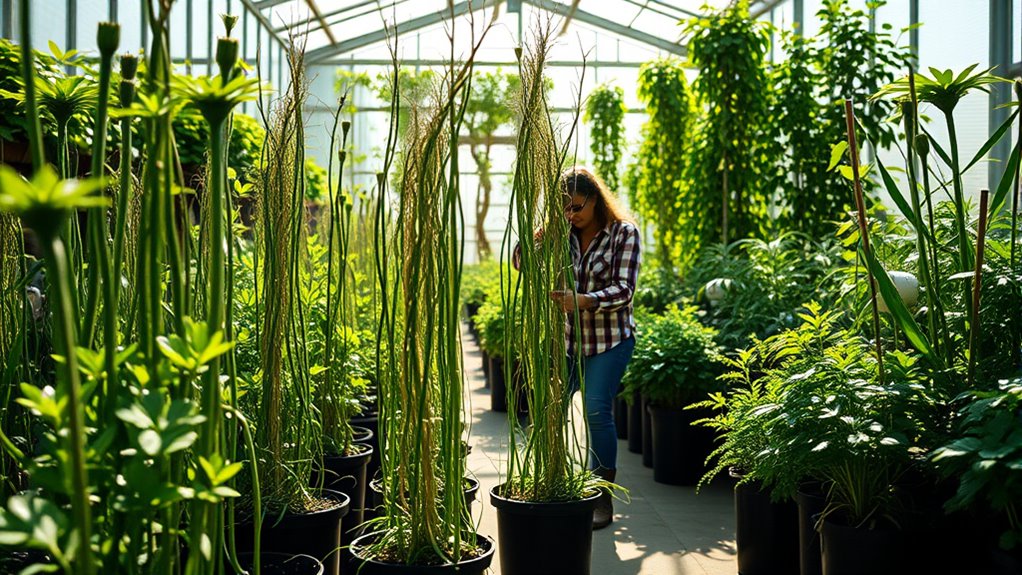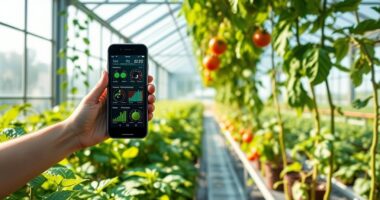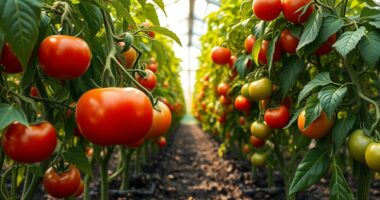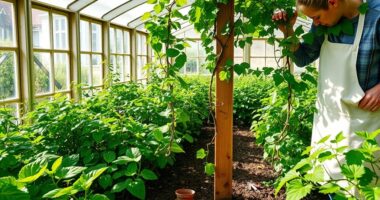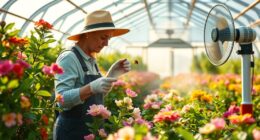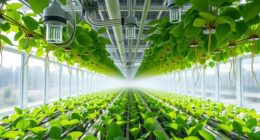To deal with leggy plants in your greenhouse, make sure they get plenty of light—aim for 12 to 16 hours daily. Keep temperatures between 65°F and 75°F, and maintain good airflow to minimize humidity and heat stress. Water from below to promote root growth, and consider pruning leggy stems to encourage bushiness. Finally, using quality potting soil can further enhance growth. If you need further strategies for healthy plants, there's plenty more to explore!
Key Takeaways
- Provide at least 12 to 16 hours of bright light daily to prevent seedlings from stretching for light.
- Maintain temperatures between 65°F and 75°F, avoiding excessive heat to reduce stress on plants.
- Ensure good airflow with fans and proper spacing to improve ventilation and minimize humidity issues.
- Water from below to encourage deep root growth and maintain consistent soil moisture levels.
- Prune leggy stems and replant them deeper in quality substrate to promote bushier growth.
Understanding the Causes of Leggy Plants

When it comes to leggy plants, understanding the causes is essential for effective management. Insufficient light is a primary culprit; seedlings stretch toward available sources, resulting in weak growth.
Insufficient light causes seedlings to stretch, leading to weak growth and leggy plants.
High temperatures over 75°F can stress plants, leading to legginess. Humidity plays a role too; overly humid conditions weaken stem development. Poor ventilation exacerbates temperature and humidity issues, while significant day-night temperature differences can further stress your seedlings.
Inconsistent soil moisture, particularly dryness, can cause stress that manifests as legginess. Soil quality matters, as fast-drying soil contributes to weak growth.
Additionally, overcrowding seedlings or using small pots restricts root development, making them stretch for light. Paying attention to these factors can help you manage and prevent leggy plants effectively.
Effective Prevention Strategies
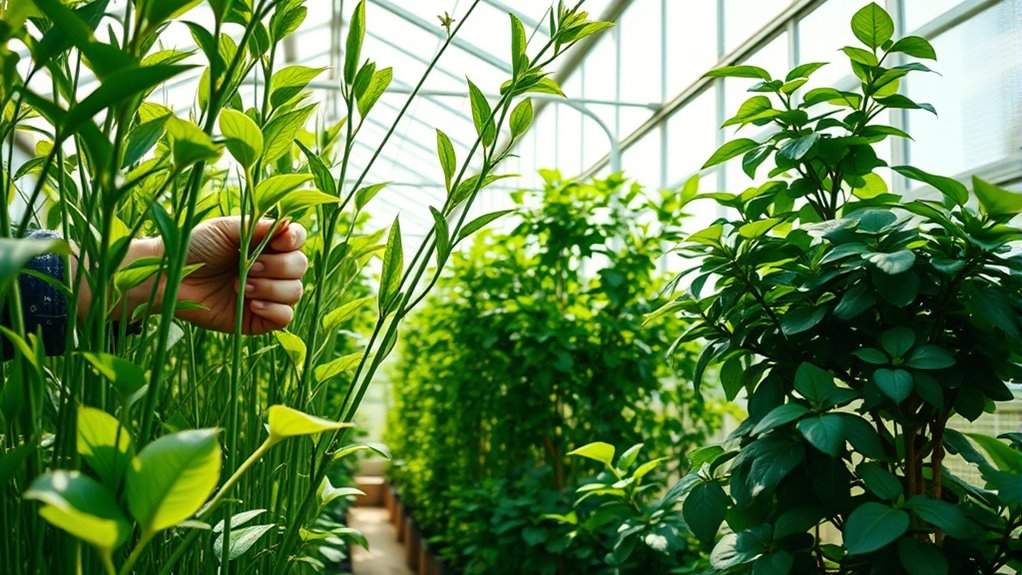
To effectively prevent leggy plants, you need to guarantee they receive adequate light, maintain ideal temperatures, and manage humidity.
Provide at least 12 hours of bright light daily, ideally 14 to 16 hours, using LED grow lights positioned just 2 inches above seedlings. Maintain temperatures between 65°F and 75°F, turning off heat mats after germination to avoid overheating.
Ensure good airflow with oscillating fans and proper ventilation to strengthen seedlings and prevent fungal diseases. Water from below to promote root growth, keeping soil moisture balanced.
Finally, choose high-quality potting soil and monitor the pH to support robust root development. Following these strategies will help you cultivate healthy, sturdy plants in your greenhouse.
Fixing Leggy Plants: Immediate Solutions

Fixing leggy plants requires prompt action, as inadequate light and improper care can lead to elongated stems.
Start by increasing light intensity; use grow lights and place them closer to your seedlings. If you have multiple trays, rotate them daily for even light exposure.
Next, regulate the temperature between 65–80℉ and avoid overusing heat mats.
Monitor your watering practices—water from below to encourage deep roots without overwatering.
Prune leggy stems to promote bushiness and consider replanting them deeper in quality substrate.
Finally, provide mild fertilization with diluted solutions to support growth, but watch out for excess nitrogen, which can worsen legginess.
With these immediate solutions, you'll help your plants thrive.
Optimizing Your Greenhouse Setup

Optimizing your greenhouse setup can considerably enhance plant growth and productivity. Start by guaranteeing adequate plant spacing for improved air circulation and light penetration, which reduces competition and disease. Additionally, proper light management is essential for preventing leggy growth in plants.
Consider vertical gardening techniques like trellises and hanging baskets to maximize space. Group plants with similar growth requirements to streamline care through effective zoning. Implement succession planting to maintain continuous yields and rotate crops to minimize pest issues and boost soil health.
Adjust your setup seasonally; maximize light exposure in spring and guarantee proper ventilation in summer. Use thermal mass for winter insulation while incorporating reflective materials in fall. Additionally, incorporating self-watering features can help maintain consistent moisture levels, promoting healthier growth.
Soil and Water Management Techniques
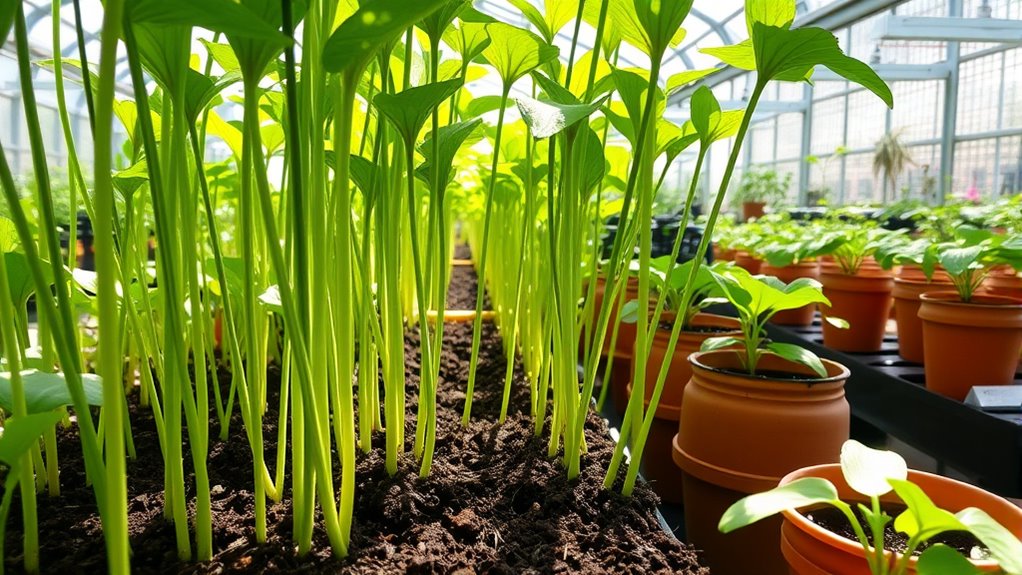
Effective soil and water management techniques are essential for fostering healthy plant growth and preventing issues like legginess.
Start by using a mix of peat, perlite, and vermiculite for ideal drainage and water retention. Incorporate coco coir or molasses to enhance water-holding capacity, and add compost or worm castings to boost soil fertility.
Regularly check soil moisture to avoid overwatering and consider bottom watering to guarantee even moisture distribution. Make sure your containers have adequate drainage holes to prevent waterlogging.
Maintain consistent moisture levels and avoid spot watering, guaranteeing thorough watering instead. Use low-concentration organic fertilizers and start fertilizing after the first true leaves appear to support balanced growth.
Adjust your soil mix based on plant type and seasonal needs.
Long-Term Solutions for Healthy Plant Growth
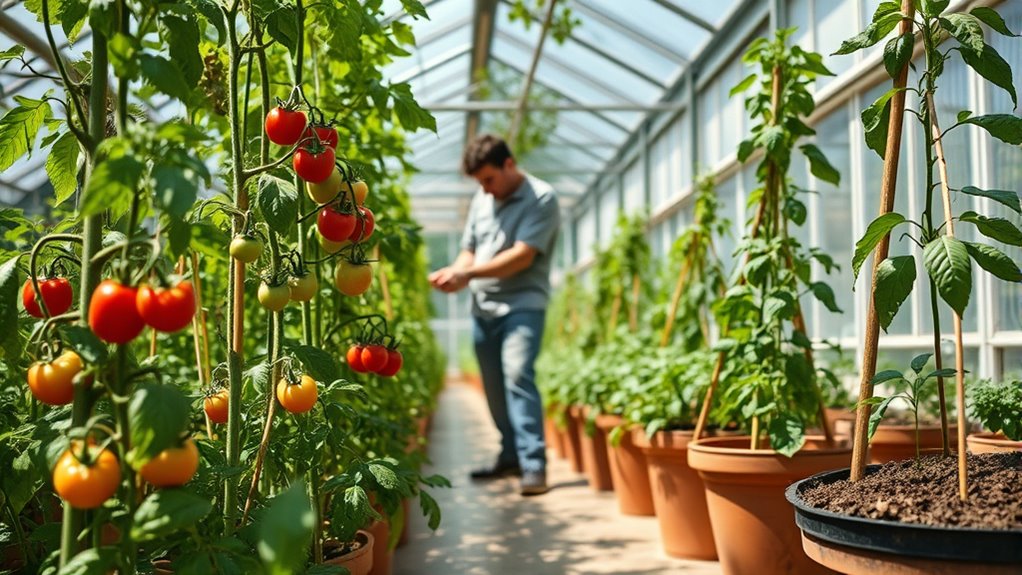
While addressing issues like legginess is essential, implementing long-term solutions for healthy plant growth is even more important.
Start by managing light effectively; position grow lights 2-3 inches from seedlings and maintain a 12-14 hour light schedule. Make sure your greenhouse temperature stays between 60-75°F and avoid heat mats after germination.
Introduce gentle air movement with fans to strengthen stems and prevent diseases. Properly space your seeds and thin them early to reduce competition.
When transplanting, do so at the right time and plant leggy seedlings deeper to encourage root stability.
Finally, gradually harden off your seedlings before moving them outdoors, ensuring they adapt well to their new environment for robust growth.
Frequently Asked Questions
Can Leggy Plants Recover if Left Untreated?
Leggy plants can struggle to recover if left untreated. Their weak stems and poor root development make them more susceptible to diseases and pests.
You might notice they produce less foliage or fruit, and their fragile structure can lead to breakage. If you want to see them thrive again, consider taking action early on.
Addressing the underlying issues, like light and spacing, can help them regain strength and energy.
How Long Does It Take for Leggy Plants to Grow Normally Again?
It depends on several factors, but leggy plants can start to show improvement within a few weeks if you take prompt action.
You'll need to guarantee they receive adequate light, proper watering, and a suitable environment. Techniques like transplanting or mechanical stimulation can speed up recovery.
Keep monitoring their progress, and with the right care, you might see them growing normally again in one to three months.
Just be patient!
Are Certain Plant Types More Prone to Legginess?
Did you know that nearly 30% of plant species exhibit leggy growth under poor light conditions?
Yes, certain types are indeed more prone to legginess. Plants like tomatoes and sunflowers often stretch towards light, creating elongated stems.
Additionally, rapid growers tend to be more susceptible. By understanding these traits, you can make informed choices about plant selection and care, ultimately promoting healthier, bushier growth and reducing the chances of legginess.
What Tools Can Help Monitor Light Levels Effectively?
To effectively monitor light levels, you should consider using light sensors like the LI-190R Quantum Sensor, which measures PAR accurately.
Devices such as the PASCO Greenhouse Sensor can track light intensity and other environmental factors.
Implementing data logging tools like the LI-1500 DLI Package helps you measure daily light integral.
For best results, verify sensors are strategically placed and regularly calibrated to maintain accuracy in your growing environment.
Is It Possible to Prevent Legginess in All Plant Species?
"You can't make a silk purse out of a sow's ear."
Preventing legginess isn't possible for all plant species due to their unique genetic traits. While you can take steps like providing adequate light and balanced nutrients, some plants are naturally predisposed to grow leggy.
It's vital to understand each species' needs and adapt your care accordingly. Tailoring your approach guarantees healthier growth, but remember, not every plant can be perfectly bushy.
Conclusion
Dealing with leggy plants doesn't have to be a constant struggle. By understanding the causes and implementing effective prevention strategies, you can create a thriving greenhouse environment. Have you imagined a space filled with vibrant, healthy plants instead of lanky ones? With proper soil management and optimized conditions, you'll cultivate strong, robust growth in no time. Embrace these techniques, and watch your plants flourish, transforming your greenhouse into a lush oasis.
